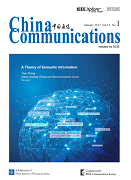NETWORKS & SECURITY
Yi Wang, Jin Li, Wenlong Huang, Tong Wen
2017, 14(1): 169-179.
Aiming at the problems of convergence-slow and convergence-free of Discrete Particle Swarm Optimization Algorithm (DPSO) in solving large scale or complicated discrete problem, this article proposes Intuitionistic Fuzzy Entropy of Discrete Particle Swarm Optimization (IFDPSO) and makes it applied to Dynamic Weapon Target Assignment (WTA). First, the strategy of choosing intuitionistic fuzzy parameters of particle swarm is defined, making intuitionistic fuzzy entropy as a basic parameter for measure and velocity mutation. Second, through analyzing the defects of DPSO, an adjusting parameter for balancing two cognition, velocity mutation mechanism and position mutation strategy are designed, and then two sets of improved and derivative algorithms for IFDPSO are put forward, which ensures the IFDPSO possibly search as much as possible sub-optimal positions and its neighborhood and the algorithm ability of searching global optimal value in solving large scale 0-1 knapsack problem is intensified. Third, focusing on the problem of WTA, some parameters including dynamic parameter for shifting firepower and constraints are designed to solve the problems of weapon target assignment. In addition, WTA Optimization Model with time and resource constraints is finally set up, which also intensifies the algorithm ability of searching global and local best value in the solution of WTA problem. Finally, the superiority of IFDPSO is proved by several simulation experiments. Particularly, IFDPSO, IFDPSO1~IFDPSO3 are respectively effective in solving large scale, medium scale or strict constraint problems such as 0-1 knapsack problem and WTA problem.
